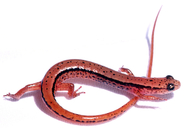|
Eurycea wilderae Dunn, 1920
Blue Ridge Two-lined Salamander Subgenus: Manculus | family: Plethodontidae subfamily: Hemidactyliinae genus: Eurycea |
 © 2011 Richard Sage (1 of 48) |
|
|
|
Distribution and Habitat Country distribution from AmphibiaWeb's database: United States U.S. state distribution from AmphibiaWeb's database: Georgia, North Carolina, South Carolina, Tennessee, Virginia
Comments Despite lacking specialized climbing structures, a wide range of salamanders are known to climb vegetation, trees, or rocks. Their ability to cling and climb allows these salamanders access to more food resources, to more suitable microclimates, and to escape predators. O'Donnell and Deban (2021) explored what factors contribute to this ability across a wide range of size, morphology, and ecological niches in salamanders. They found that the adhesive nature of their mucus coating was a major factor, but that cling ability also was associated with body mass and the amount of body contact area utilized, which include feet, tail, belly, and ventral surface of their head, to increase cling. The best clingers in their experiments were the small plethodontid salamanders, such as Batrachoseps attenuatus, Desmognathus aeneus, D. ocoee, Eurycea guttolineata, and E. wilderae. However, plethodontid salamanders in general, like large salamander Desmognathus quadramaculatus, were comparable or exceed the cling ability of arboreal and scansorial frogs. (Written by Ann Chang) This species was featured in the News of the Week on April 21, 2025: In some animals, individuals of the same sex adopt one of several distinct mating strategies—a phenomenon known as alternative reproductive tactics. For amphibians, alternative reproductive tactics are typically environmentally determined, plastic (and reversible), and without accompanying morphological differentiation. A striking exception can be found in the Two-lined Salamander (Eurycea bislineata) species complex, in which some populations exhibit two distinct male phenotypes. “Searching” males use elongate cirri and mental glands for mate location and courtship on land, while “guarding” males develop hypertrophied jaw musculature used in mate-guarding at nesting sites. Kalki and Pierson (2025) analyzed genome-wide SNP data from Eurycea cf. wilderae of known sex and reproductive and provide evidence for XY sex determination and for a Y-linked polymorphism underlying alternative reproductive tactics. They also developed and validated a PCR-based genotyping assay for characterizing the sex ratio and relative frequency of male tactics from a sample of larvae, providing intriguing avenues for future research. (Written by Todd Pierson) Watch Eurycea wilderae use its projectile tongue in slow motion: Edited by: Michelle S. Koo (2025-04-20) Species Account Citation: AmphibiaWeb 2025 Eurycea wilderae: Blue Ridge Two-lined Salamander <https://amphibiaweb.org/species/4061> University of California, Berkeley, CA, USA. Accessed May 7, 2025.
Feedback or comments about this page.
Citation: AmphibiaWeb. 2025. <https://amphibiaweb.org> University of California, Berkeley, CA, USA. Accessed 7 May 2025. AmphibiaWeb's policy on data use. |




 Raffaëlli Account
Raffaëlli Account Map of Life
Map of Life